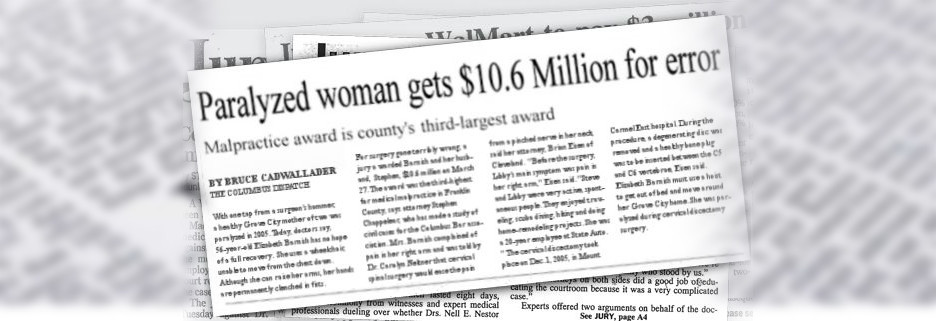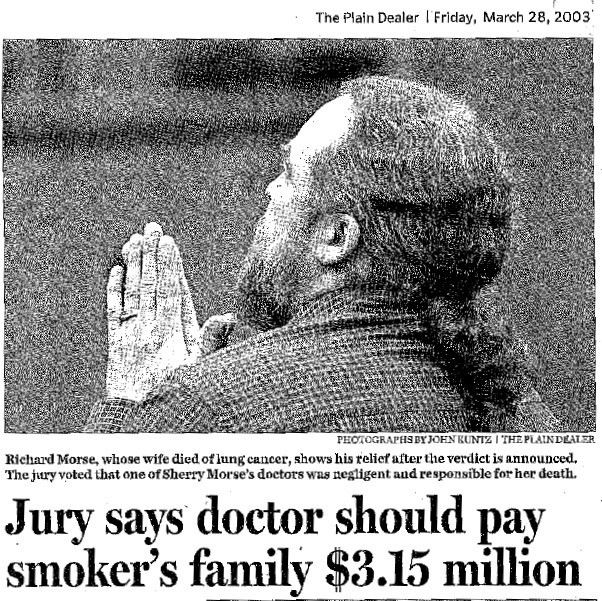The Eisen Law Firm is proud of its many victories in the fight to obtain maximum compensation for individuals seriously injured by the negligence of others.
Some examples of those victories are described below:

Danny T. died as the result of negligence. The details are confidential, but Danny's widow filed suit and received a multi-million-dollar verdict. That was, however, only the beginning. The defense appealed. Again, the widow won. Further litigation followed, including additional appeals. Attorney Brian Eisen worked relentlessly on this matter for several years. Eventually, his dogged persistence won out, and Danny's widow and family received a total award in excess of $15.3 million.
Read More...
Libby Barnish was devastated when she was unable to move her legs after waking up from spine surgery. When two reputable law firms told her that it would be too difficult to prove that her injury was the result of medical negligence, she almost lost all hope. Then she came to the Eisen Law Firm.
To read about what happened to Libby, click here:
James was delivered by Cesarean section after his mother’s uterus ruptured during labor.
Read More...
Julie D was 25 weeks pregnant when she presented to the Labor and Delivery department of her local hospital with a headache and vision problems.
Read More...
Rebecca Smith was delivered by Cesarean section after a prolonged labor.
Read More...
Daphne West was evaluated by a nurse practitioner at the office of her family doctor. She complained of numbness in one arm and actually fainted in the office.
Read More...
Mrs. A was 84 years old when she underwent heart surgery at a local hospital.
Read More...
Phyllis Hutchins had a small area of weakness (called an “aneurysm”) in her abdominal aorta, one of the main arteries in her body. This aneurysm had to be repaired surgically.
Read More...
Dave W. was dressing one morning when he felt a snap in the front of his neck, followed by pain in his chest and head.
Read More...
Mrs. W had a routine arthroscopic knee surgery at an ambulatory surgical facility.
Read More...

For over two years, Sherry Morse complained to her family practice physician of a cough. She was repeatedly advised she had “bronchitis” and was given prescriptions for antibiotics. Although she was a heavy smoker, her doctor never suggested a chest x-ray. Finally, a car accident led to an MRI and a chest x-ray. Mrs. Morse was diagnosed with Stage IV lung cancer
Read More...
Near the end of a two-week medical negligence trial against two sets of defendants, Defendant #1 called his key expert witness on direct examination. After Mr. Eisen cross-examined him, Defendant #2 was permitted to examine the expert. Instead of limiting the examination to matters raised on direct examination, however, Defendant #2 elicited new opinions from the expert. When Mr. Eisen stood up to cross-examine the expert on the new opinions, the judge refused to allow it. Since the expert’s new opinions went unchallenged, the jury believed everything he said. It was no surprise that the jury returned a defense verdict.
The Eisen Law Firm refused to accept defeat in this fashion, so it filed an appeal and asked for a new trial. On appeal, Mr. Gurney argued that it was reversible error for a trial court to permit a defendant to elicit new opinions from an expert, and then deny the plaintiff an opportunity to cross-examine the expert on those new opinions. The appellate court agreed, reversing the trial court’s decision and ordering a new trial. The Defendants tried to appeal to the Supreme Court of Ohio, but they were rejected. The case then settled shortly before the retrial, which would have included full and fair cross-examination.
Shelley unexpectedly suffered a cardiac arrest in her car. Her husband called 911, and paramedics arrived, resuscitated her, and brought her to the emergency department. An EKG was done, and there was a dispute between the ED physician and the on-call cardiologist as to whether it showed a STEMI that required emergent transfer to the catheterization lab. After a delay of several hours, Shelley eventually was transferred and underwent cardiac catheterization. Unfortunately, it was too late. She died shortly after the procedure. She was only 57 years old...
Read More...
Mrs. J underwent a colo-rectal surgery at a large hospital.
Read More...
Mr. E was 75 years old when he was diagnosed with gallstone pancreatitis. He was scheduled to undergo an endoscopic procedure, and the anesthesia plan was to put Mr. E into a state of “deep sedation,” as opposed to “general anesthesia.”
Read More...
Rose K. was a 45 year old woman who presented to her local emergency department with side pain for a few days.
Read More...
Mr. D presented to the ER at his local hospital with all of the classic signs and symptoms of the flu. But, this wasn’t any regular flu season.
Read More...
Mrs. K went to the emergency department for an acute flare-up of diverticulitis and was admitted to the hospital for pain management.
Read More...
Mrs. S was referred to an ENT surgeon to remove a benign tumor in her neck. The surgical plan involved the use of a monitoring device to help the ENT find – and avoid cutting – Mrs. S’s facial nerve.
Read More...
Mr. G went to the emergency room complaining of severe abdominal pain and flu-like symptoms. He was given a single dose of a strong painkiller and, a few minutes later, a nurse found him unresponsive.
Read More...
Mrs. L was diagnosed with a “hernia.” That means a small portion of her stomach was protruding through her abdominal cavity and into her chest cavity, through an opening meant only for the esophagus. Her surgeon recommended a procedure to repair the hernia.
Read More...
For more than three years, Jane D. saw her primary care doctor for pain that began following a car accident. Jane’s doctor did little to get to the cause of Jane’s pain. Instead, he prescribed dangerous combinations of narcotic pain medications and benzodiazepines. And he did so in ever-increasing dosages, and in the face of clear evidence that Jane was a prescription medication addict.
Read More...
Bruce D. suffered from a chronic condition that required him to make an annual trip to a hospital for a minor surgical procedure.
Read More...
After obtaining a jury verdict of $2 million against Sam’s Club (a Wal-Mart subsidiary) for the wrongful death of a dockworker, The Eisen Law Firm filed a separate lawsuit against Wal-Mart for “spoliation of evidence” for withholding critical evidence prior to trial.
Read More...
Mr. S was admitted to the hospital for rehabilitative and physical therapy following surgery.
Read More...
Mrs. Z was scheduled for outpatient laparoscopic surgery.
Read More...
Mrs. C had suffered a progressive loss of vision over a relatively short period of time. She went to see a neurosurgeon, who determined that her symptoms likely were the result of a tumor located above the pituitary gland at the base of her brain.
Read More...
Mr. E saw an orthopedic surgeon for problems with his left hip. The surgeon recommended a total hip replacement.
Read More...
Doris Sawyer had a partially-blocked coronary artery.
Read More...
Jessica R. was 28 weeks pregnant when she presented to a local hospital with severe abdominal pain. She was evaluated and diagnosed with pancreatitis, and she was admitted to an intensive care unit.
Read More...
Kevin was a young man with a history of significant medical problems. He was admitted to an Ohio hospital with gallstones.
Read More...
Following Mr. F’s back surgery, certain orders were given to prevent deep venous thrombosis (“DVT”) and pulmonary embolism (“PE”).
Read More...
Danny A. was 55 years old when he underwent a liver transplant due to damage caused by hepatitis B, a viral infection of the liver.
Read More...
Mr. H was diagnosed at his local hospital with endocarditis, a potentially life-threatening condition in which a heart valve is infected with bacteria.
Read More...
Mr. N was pulling up to a four-way intersection in rural Ohio when he was t-boned by a truck driver who failed to stop at the stop sign. Mr. N, and his minor son who was in the passenger seat, both were severely injured and had to be life-flighted to the hospital. Mr. N required immediate surgery, and was left with permanent and substantial physical injuries to his left wrist and right hip.
Read More...
Mrs. B complained to her family doctor about pain in her hip. The family doctor referred her to an orthopedic specialist.
Read More...
Caroline was four years old when she fell off of her bed and broke her arm. Her mother took her to the hospital, where an orthopedic surgeon reset Caroline’s arm and put it in a cast.
Read More...
One week after starting a new medication for his diabetes, Mr. P presented to his physician’s office complaining of upper abdominal pain radiating to his back.
Read More...
Jack was born with Down syndrome, a genetic condition which affects kids along a spectrum.
Read More...
Mr. R had a remote history of blood clots in his legs and a serious neurodegenerative disease. After a flare-up of his neurodegenerative disease left him with reduced mobility, Mr. R was sent to a rehabilitation facility.
Read More...
Mr. J was 79 years old when he presented to the emergency department at his local hospital after falling in his kitchen earlier that day.
Read More...
Mr. K was a 66–year-old man who came to his local hospital after suffering a small stroke. Because of the stroke, Mr. K had difficulty swallowing and clearing his secretions.
Read More...
Marvin H. was a 45 year-old man who suffered from chronic pain in his mid-back. A neurosurgeon performed a procedure on him called a “thoracic laminectomy.”
Read More...
C.J. was two and a half months old when he went to the Emergency Department at a Cleveland-area hospital. He was diagnosed with a small bowel obstruction and admitted for surgery. Following surgery, C.J. was admitted to the Pediatric Intensive Care Unit (“PICU”).
Read More...
Lynn G was a 60-year-old woman with one adult child who died a few weeks after receiving dialysis at a dialysis center.
Read More...
Following a car accident, Willie D. was rushed to a Cleveland-area hospital, where he was operated on by a physician employed by ABC Hospital. During surgery to repair Willie D’s thoracic aorta (the main blood vessel carrying oxygen-rich blood from the heart to the rest of the body), a surgical trainee improperly inserted a catheter through the aorta. Willie D. lost the use of both arms. After a lengthy trial, a confidential settlement was reached during jury deliberations.
Herman S. was an active 77 year-old man, who fainted while running on a treadmill. He hit his head and suffered a small brain bleed.
Read More...
Mr. G was a 31-year-old husband and father who died of a pulmonary embolism approximately one week after back surgery.
Read More...
Mr. L was 55 years old when he presented to a hospital in Cleveland, Ohio, with complaints of severe hip and back pain and an unexplained fever.
Read More...
Steve K. began to sweat and have chest pain on the first day of his job in the legal department of his local hospital. He was taken to the emergency department.
Read More...
Ron T. was 67 years old when he went to the emergency department at a local hospital with a chief complaint of chest pain.
Read More...
Sammie H. was a 65 year old woman with end-stage renal disease. She lived in a nursing home and required dialysis three times per week.
Read More...
Greg R. was 70 years old when he was diagnosed with Stage IV lung cancer. It was a total shock to Greg because he previously had a suspicious mass in his lung biopsied and was told it wasn’t cancer. It turns out, however, that the doctor who did the biopsy was not able to obtain any tissue from the mass itself; instead, he only obtained tissue surrounding the mass.
Read More...
Mrs. C was in her late 70s and had significant heart failure and other medical problems. She had a pacemaker that would stimulate her heart when it started to beat too slowly.
Read More...
Sally and John were excited to start their family. After months of trying to conceive, Sally went on the fertility drug, Clomid. The Clomid worked, and Sally became pregnant.
Read More...
Mr. and Mrs. Stone were so excited to have their first child. Mrs. Stone had a routine pregnancy and routine medical care up until June 25th. On that day, at approximately 27.5 weeks into her pregnancy, Mrs. Stone began to feel abdominal pain.
Read More...
Anaya, a young, soon-to-be mother, was scheduled to be induced. Upon arrival at the hospital, an electronic fetal monitor was placed to monitor the baby’s heart rate and the progress of uterine contractions.
Read More...
Mrs. V died from a condition called thrombotic thrombocytopenia purpura (“TTP”). TTP is a blood disorder characterized by blood clots that form in small blood vessels in the body.
Read More...
Mrs. T had a stomachache. But, unlike other stomachaches, this ache was so severe that Mrs. T went to the hospital.
Read More...
Dan G. was a 31-year-old husband and father who died of a pulmonary embolism approximately one week after back surgery.
Read More...
Joy had good prenatal care, she was at full term, and all signs pointed to a normal and healthy baby on the day she went to the hospital to deliver.
Read More...
Tabitha C. was 45 years old and a very active and successful business woman.
Read More...
Francine K. was in her early thirties when she felt a lump in her breast during a self-examination.
Read More...
In the middle of winter, Jason Jones took his three children to the emergency department of his local hospital. The children were complaining of headaches, fever, nausea, and vomiting.
Read More...
Mark Mitchell was a successful businessman who had a routine surgery at an Ohio hospital. Although the surgery went well, Mr. Mitchell developed a post-operative infection.
Read More...
Alejandro Ramirez was admitted to a trauma center after an automobile accident.
Read More...
Kenny Tripp was admitted to his local hospital with chest pain.
Read More...
Vincent Kenne presented to the emergency room of his local hospital complaining of chest pain.
Read More...
A confidential settlement was reached when the defense took a surprising position stating that the medical condition and deteriation of 63-year-old Larry could not have been seen by the cardiologist and nothing could be done to prevent his death.
Read More...
Marisa C. went to her orthopedic surgeon, complaining of pain in her left knee. The pain had been bothering Marisa for eight months. The doctor recommended arthroscopic knee surgery for a torn meniscus and scheduled this surgery to take place at the ambulatory surgical center where he regularly operated.
Read More...
Beth S. was 15 years old when she and her mother made an appointment for Beth to see an adolescent psychiatrist in a small town in western Ohio.
Read More...
Shortly after going to bed one evening, Scott G. woke up with a horrible headache and pain behind his right eye. He also had trouble breathing and was severely nauseated.
Read More...
Jake was two years old when a misdiagnosis caused him to lose his hearing and impaired his ability to walk. Jake had a fever for several days.
Read More...
While he was getting clothes out of his closet one morning, Gabe (60 years old) fell backwards and hit the ground.
Read More...
One winter morning, Bruce went to an urgent care facility in a suburb of Cleveland, Ohio. He had experienced chest pain while shoveling snow earlier that morning.
Read More...
Mrs. Bee was only 66 years old when repetitive medical errors in treating her led to her death. The Eisen Law Firm worked on this case to get a confidential settlement to help the family pay for expenses and the other costs to be covered following the passing of a loved one.
Read More...
Chloe was a premature child, born at only 25 weeks. Shortly after her delivery, Chloe was dropped by a nurse and needed immediate neotal intensive care. The Eisen Law Firm secured a confidential settlement for the family.
Read More...
Mr. Romano woke and made himself breakfast as he usually does. He then experienced sudden, severe pain in his stomach. He tried going to bathroom, but it didn’t provide any relief.
Read More...
Jim Parre was admitted to a rural hospital for an elective abdominal surgery. The surgery was successful and uneventful.
Read More...
Mark Pellerin thought something might be wrong with his health. He went to see his primary care physician, complaining of a painless lump in his right neck.
Read More...
HS was 13 years old when he was placed in the temporary custody of Children and Family Services (“CFS”).
Read More...
Steve Andrews was only 38 years old when Dr. Jones recommended surgery to remove a benign nodule on his adrenal gland. The nodule was discovered incidentally on a CT scan looking for a possible kidney stone.
Read More...
Lyndsay Biggar was eight-plus months pregnant in 2019, and working at her job as a law enforcement officer, when she felt a gush of fluid. Convinced her water had broken, Lyndsay called her obstetrician’s office.
Read More...
A Never Event is something bad that happens to a person in a hospital that never should have happened. Things like operating on the wrong patient or operating on the wrong site of the right patient.
Read More...
On August 6, Mr. Malkinne died of cardiogenic shock caused by a heart attack. The precise timing and nature of the heart attack is not entirely clear
Read More...
This case falls under the “OMG, No They Didn’t” category. I mean a jaw-dropping error.
Read More...
With rashes on his back, J. Dragar went to the Urgent Care facility near his home. The physician diagnosed him with Shingles and prescribed Valtrex. Unfortunately, the physician gave the “standard dose” instead of the adjusted “renal dose,” despite knowing that Mr. Dragar was on peritoneal dialysis for end-stage kidney disease.
Read More...
Mr. Hope was a classic “eggshell skull” plaintiff, meaning he had underlying conditions that made him more susceptible than the average person to injury. Those conditions included diabetes, end-stage renal disease, coronary artery disease, and COPD. But he was receiving great medical care from a local healthcare system, and he was doing relatively well. He was living at home, driving, taking care of himself, and living a normal life.
Read More...
Joe Lane was 66 years old when he went to the emergency department complaining of pain in his calf. The ED physician diagnosed him with a blood clot in his leg (deep vein thrombosis or “DVT”), and prescribed Eliquis for treatment.
Mr. Lane was given a written prescription for Eliquis (10mg, twice daily for seven days), and was advised to get it filled and to start taking it that evening. His wife drove him home from the hospital and took the prescription directly to her local big chain pharmacy.
Unfortunately, the pharmacist did not fill the prescription. According to Mrs. Lane, the pharmacist said the prescription was “written wrong.” But according to the pharmacy, the prescription was rejected by Mr. Lane’s insurance plan.
Read More...
Mr. Penn was 66 years old and had been suffering from chest pain. He went to see a cardiologist, who explained that his chest pain was a symptom of “premature ventricular contractions,” which is when the bottom chambers of the heart produce extra heartbeats. Those extra heartbeats disrupt the heart’s normal rhythm. After lifestyle changes and medications were not effective in restoring a normal heart rhythm, Mr. Penn’s cardiologist recommended a catheter ablation.
Mrs. Summers had been taking thyroid medication for many years. She always went to the same local branch of a national pharmacy to refill her prescription. Unfortunately, on one of her visits, the pharmacist filled the prescription incorrectly with sleeping pills instead of her usual thyroid medication.
Read More...
Mr. G had a PSA screening test, and the results were abnormally elevated. His doctor assumed it was merely an inflamed prostate and prescribed antibiotics. But then the doctor didn’t follow up. He didn’t order another PSA test to see whether the antibiotics brought the PSA level down to normal, or whether he needed to order a biopsy and refer Mr. G to a urologist for evaluation of possible prostate cancer. A year later, Mr. G (coincidentally) had blood testing done for a life insurance application, and his PSA was even more elevated. He went to see a urologist, who immediately ordered a biopsy and other tests. Unfortunately, Mr. G was diagnosed with Stage IV prostate cancer. Since the cancer had already spread outside of his prostate and into his bones, it was too late for surgery. If it had been caught sooner, Mr. G would have had his prostate surgically removed, his treatment course would have been limited, and he would have had a much better chance at a full recovery.
Read More...




